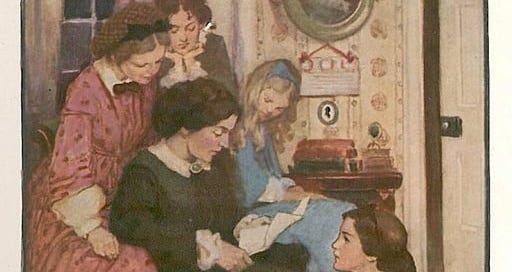The School for Housewives brings you short, practical, and thoughtful messages to inspire you to make your home.
If you’re new here, go to the homepage for the previous Lessons; the categories are arranged in the menu bar at the top.
The comment on a silly little clip of a British lady from the 50s said something like, “When did we lose musicality in our voices?”
There are definitely trends and fashions in speaking. The trend today, ironically for the ascendent ideology, is for women to have speech patterns that exhibit lack of confidence. The very cadence seeks affirmation and does not invite listening. Often those public figures setting the style demonstrate inferiority by being too masculine — their voices are artificially low and forced — or weirdly high and childish.
The feminine voice should have warmth, strength, and softness, neither cringing passivity nor a grating, repellant harshness.
Avoid “vocal fry” — it is as ubiquitous as it is painful to hear; a scourge upon the land.
To achieve your very own best speaking voice — and believe me, as someone who has to listen to recordings of my voice on a regular basis, I understand not liking how one sounds — allow me offer some tips for a more feminine way of speaking:
Slow down a little — put some space around your words, at least the important ones. Breathe, even in the middle of a sentence, but don’t take a sharp breath just before you start speaking. Relaxation is important to a pleasant sound.
Be attentive to others’ annoying patterns of speech and grating sounds. In your head, imagine how this lady in the video could have said the same thing, but nicely. Notice the volume. Ask, “Am I simply shouting?” or contrariwise, “Can they actually hear me?”
Most importantly, be brave in imitating what you love. That’s how we learn. Unconsciously, we are imitating bad examples, as a society. Each person has a comfort zone in the vocal cords, but won’t find it without experimentation. Listen to good audiobooks. One of my favorites is What Alice Forgot, narrated by Tamara Lovatt-Smith. I admit I have a weakness for the Australian accent, but the timbre of the narrator’s voice is admirable. We need role models!
Reading aloud to children offers a lot of practice. In this post I have some tips for doing it well. Doing the “voices” of the characters by adjusting your voice just a bit for each one helps you explore your range and sweet spot. Give one of them “vocal fry”! Doing it intentionally helps identify and eliminate it.
The more you practice by imitation the better you will sound!
Work on having your own voice, whatever its quality, be more feminine.
Jessie Wilcox Smith, Little Women
As with everything here at the SFH, the best thing is for you to take my ideas, coming from my experience of 45 years of marriage and raising seven children, and apply them to your situation with discernment, prudence, and confidence — and a sense of humor!
If you don’t wish to subscribe just now, I understand! How about…
For the longer version:
My book on how to live with the Liturgical Year: The Little Oratory






Two fantastic examples of this is the movie "In A World" (hilarious for its vocal mockery) and a clip in Youtube on Loudermilk called "Vocal Fry" https://www.youtube.com/results?search_query=In+A+World+movie+vocal+fry+mockery (warning: some explitives but nailed it). Keep a smile in your voice and draw them in; this was my mother's admonition.